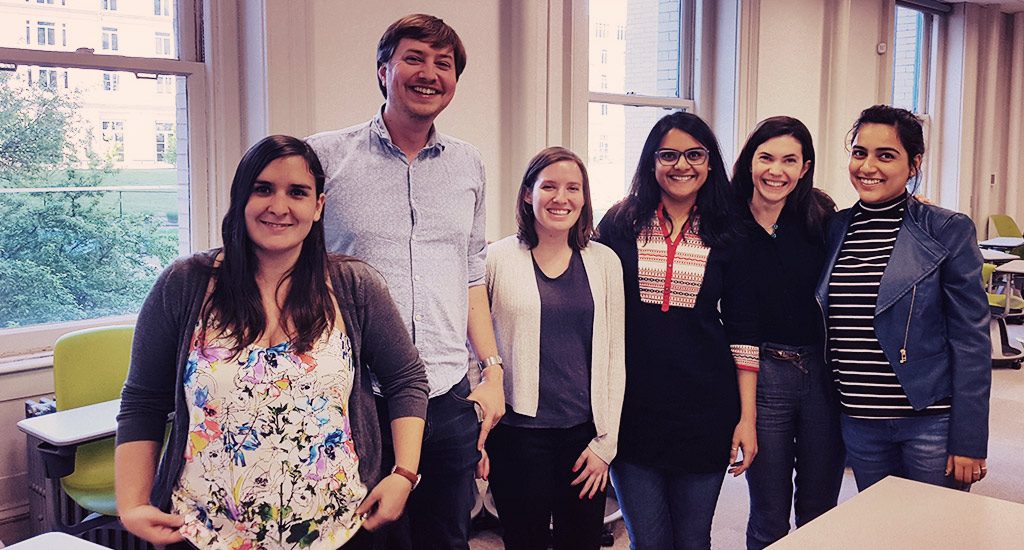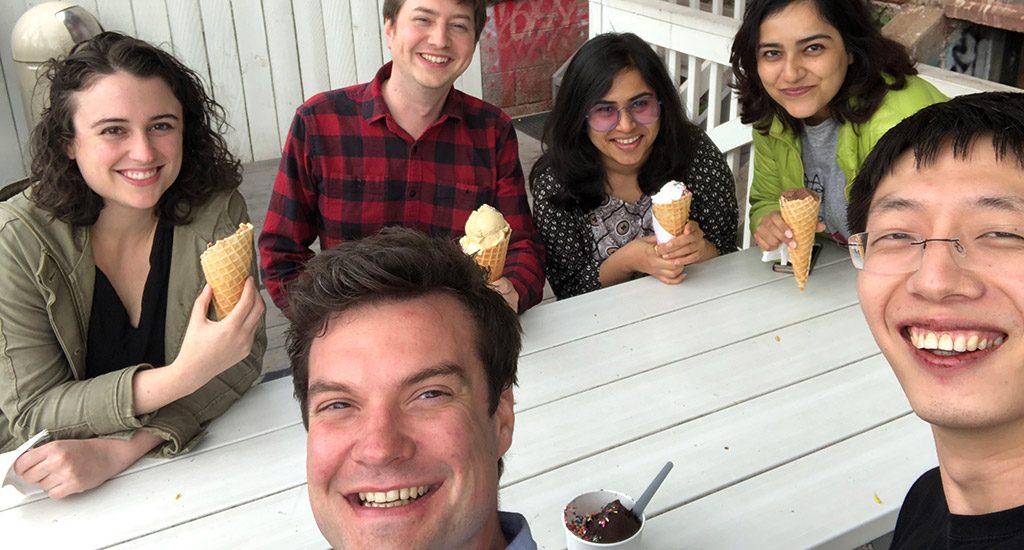- Lab members in May 2017: Silvia Mata-Marin, Dan Lockton, Delanie Ricketts, Nehal Vora, Theora Kvitka, and Ashlesha Dhotey
- A lab group photo from May 2018: Katie Herzog, Matt Prindible, Dan Lockton, Devika Singh, Ashlesha Dhotey, and Shengzhi Wu
Introduction
How we imagine affects how we understand the world, how we live, and what we see as possible in our collective futures, with consequences for sustainability, society, our relationships with technology, and our everyday lives.
At the Imaginaries Lab, a new (2017—) research studio, we believe that humanity needs tools to enable new ways of understanding and imagining, and new ways to live, that provide more equitable socially and environmentally sustainable futures. We create those tools through developing creative research methods, adapted from those used in design practice, and explore their use in a variety of cross-disciplinary contexts.
A team of Master’s, PhD and undergraduate student research assistants are working with Assistant Professor Dan Lockton to build on his international research track record around interaction design for behavior change. We are using creative approaches to envision alternative ways of thinking and living, now and in the future, to inform interdisciplinary academic research and practical applications for social and environmental benefit. The group’s goal is to become a world-leading center for this kind of research, collaborating internationally and across disciplines to support transformative innovation. We carry out research projects, teach studio classes, publish and run workshops internationally, and build collaborations externally and within Carnegie Mellon.
Our three main research areas are:
Imaginaries, mental models, and mental imagery: using design methods to investigate how people understand abstract or complex concepts (from mental health to energy to metaphor generation to the structure of disciplines themselves), help them understand and imagine in new ways, and imagine new ways of living. This research covers the development of creativity methods (both analog and digital), workshop and facilitation methods, and new kinds of interface design (human-computer interaction) and qualitative data visualization.
Design, behavior change, and agency in systems: exploring the links between designed technology, services, and environments, and influence on human behavior, particularly in relation to sustainability and social benefit, and how designers can practically engage with issues of ethics and effects within the systems of everyday experience. The Design with Intent toolkit is one of the most highly-cited pieces of work in this field, both academically and through use in design practice.
Research through design, and design as inquiry: investigating the use of design practice as a form of research and creative inquiry, including ‘critical making’, speculative and critical design, and how design methods can contribute to new knowledge generation beyond the design discipline itself.
Read more about the ideas behind the Imaginaries Lab, who we are, and the projects we are working on. Our blog will chronicle the work we are doing, with opportunities to be involved—you can also subscribe to our occasional newsletter for news of our activities.
Contact: Dan Lockton, danlockton@cmu.edu
More information on the lab’s work
In our research framing, ‘understanding understanding’ is part of a progression from examining mental models to enabling new forms of agency for people—not to be on the receiving end of ‘behavior change’, but to be able to change the behavior of the systems they are in. The integration of these perspectives with influences from a range of fields including sociology, behavioral and decision sciences, cognitive anthropology, pattern languages, cybernetics, and social innovation, led to the idea of imaginaries as a design material: a focus for creative inquiry into questions of how we interpret, imagine and interact with the world—institutions, the environment, cities, infrastructures, technologies and complex systems around us—how they, in turn, model us, and what the consequences could be for design which seeks to enable human agency as part of transition to more sustainable futures. The imaginaries research focus dovetails well with Carnegie Mellon College of Fine Arts’ focus on creative inquiry. My design for behavior change work, and the methods associated with it, also fit well with CMU’s significant expertise in human-computer interaction, behavioral economics and decision science.
The Imaginaries Lab is a way to group this work in a coherent form which can be built on within the contexts of academic funding and collaboration models within CMU, other research universities, and internationally, where a ‘lab’ model is often a default and expected form for research-active faculty to work with graduate students, publish, and collaborate. Equally, the lab can enable teaching to be built around, and integrated with, the research topics.
In our Imaginaries Lab research, my group of graduate research assistants and I are building on work around interaction design for behavior change, mental models, and understanding, to explore bigger questions around how the ways in which people think about, understand and imagine concepts, and the agency they perceive they have, affects what they do. We are also interested in ways of enabling new imaginaries, ways in which people can speculate, envision and reflect on different and alternative ways of living and being, both now and in the future (including speculative design). We are using design methods to investigate these questions, to inform both academic research in other disciplines and practical applications for social and environmental benefit.
Our projects in our first eighteen months have included: mapping people’s mental imagery through landscape metaphors using physical models (Mental Landscapes—working with Delanie Ricketts); exploring communities’ understanding and perceived agency to shape the future of their local area (Pittsburgh Civic Visions—Ashlesha Dhotey, Matt Prindible, Theora Kvitka, Nehal Vora, and Silvia Mata-Marin), including a collaborative workshop with the City of Pittsburgh’s OnePGH resilience team; and building and testing new forms of data sonification for energy use (Electric Acoustic—Shengzhi Wu, Devika Singh and Gray Crawford), extending the direction of my previous RCA project Powerchord through an installation in Margaret Morrison Carnegie Hall in May 2018, funded by a College of Fine Arts’ Fund for Research and Creativity grant, and using data provided by CMU Facilities Management Services. The Electric Acoustic booth at the 2017 Pittsburgh Maker Faire at the Children’s Museum was a valuable way to build public engagement around the topic through a practical research activity, and our RAs received awards from the Maker Faire organizers.
The Electric Acoustic project is an example of a new theme emerging from the lab’s work, the notion of qualitative user interfaces (or QUIs). We believe there is potential for more qualitative forms of display and interface—analog and digital—to help design and HCI engage better with imaginaries and mental imagery in helping people understand the complex systems around them. We have published a CHI work-in-progress paper in 2017 outlining a possible taxonomy for qualitative interfaces (also published as a Medium post for greater exposure) and in Spring 2018, research assistant Katie Herzog has started development of a QUI gallery website which will explore and present the concept through examples. Invited workshops on QUIs have been part of the lab’s work in 2017–18, including at the Universidad del Desarrollo in Santiago, Chile, and the Google SPAN conference in Pittsburgh, and the concept has contributed to teaching in Environments Studio IV.
Arising from both the Mental Landscapes and QUI projects, New Metaphors is another novel ‘big picture’ direction for exploration, which so far has been the subject of both teaching in MDes Seminar III and Persuasion (and in Deepa Butoliya’s Speculative (Post-)Critical Design class) and workshops at international industry conferences (IxDA Interaction 18 and UX Lisbon). New Metaphors explores the potential of generating—and applying—novel metaphors for complex, large-scale, and difficult-to-explain concepts in relation to global, local, and personal challenges and futures, as a form of speculative design; the goal is to arrive at new sets of metaphors for understanding a range of issues, empirically validated as offering new insights and perspectives. The project uses art and design research methods, including creative workshops, generative creativity processes (including a form of machine learning), and cross-cultural participation, to examine how an expanded conceptual vocabulary could help improve public understanding, and reframe debate.
Going forward, the Imaginaries Lab’s evolution will necessarily need to be through collaboration and partnership with other groups within CMU and externally, not least to access the funding needed to develop more securely-founded projects. Larger external grant applications, and foundation and commercial partnerships are a vital part of the lab’s future, and we are working hard to identify routes within CMU for this kind of initiative to be supported. The Imaginaries Lab newsletter has over 500 subscribers all over the world as of May 2018, and its profile is becoming more prominent through publications and conference presentations; this kind of profile is needed, we believe, for successful external engagement.


